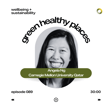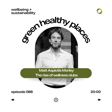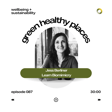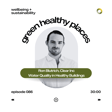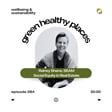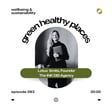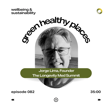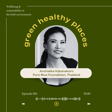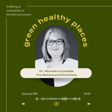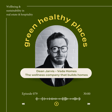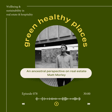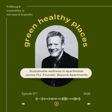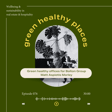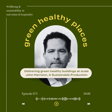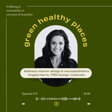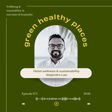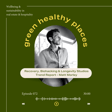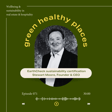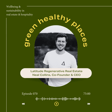Become a Creator today!Start creating today - Share your story with the world!
Start for free
00:00:00
00:00:01

Building Biology & Sustainability
GUEST / JOHANNES SCHMIDT
- https://buildingbiology.com/
- https://buildingbiology.com/building-biology-course/
- https://www.baubiologie.de/downloads/25principles.pdf
HOST / MATT MORLEY
CONVERSATION HIGHLIGHTS
- The roots of healthy buildings and building biology are here in Germany
- If you study medicine, you learn about illnesses but not about sickness caused by spending time in a building
- In any house, the most important place from our perspective is the bedroom
- We have drastically changed the way we live over the last few generations. Just 100 years ago, we spent much more time outdoors.
- We don't want to say we have to go back to the Stone Ages. I'm using a computer, I use electricity, in the institute we simply use it in a more efficient, less harmful way.
- We should use our bodies as a tool for movement in a natural environment every day.
Transcript
Introduction and Guest Welcome
00:00:10
Speaker
Welcome to episode 37 of the Green and Healthy Places podcast, in which we discuss wellbeing and sustainability in real estate and interiors. I'm your host, Matt Morley, founder of Biofilico Healthy Buildings and Biofit Wellness Concepts.
00:00:27
Speaker
This week I'm talking to Johannes Schmidt of the Institute of Building Biology and Sustainability in Germany. Johannes manages the Building Biology course offered by the Institute in English online and is something of an authority on the subject.
Origins of Building Biology
00:00:42
Speaker
We discuss how building biology in Germany in some ways predates the healthy building movement in the US. We look at the concept of human-centric design in buildings, how building biology was one step ahead of post-COVID ventilation strategies, as well as the importance of a bedroom that is free from
00:01:02
Speaker
electromagnetic radiation and fields and also how thinking about our bodies as a tool to be used in nature every day is at the root of the entire building biology value system. If you enjoyed this episode please hit subscribe. Both of our contact details are in the show notes. Now it's time to dive into this wonderful world of building biology.
00:01:25
Speaker
Great to have you here. Please, let's start with the basics for today. Can you tell us about the history and a bit of the background to the concept of building biology in Germany? Of course, yes. The history of the institute is that it actually was founded by Professor Dr. Antoine Schneider and that was done in the
00:01:51
Speaker
Yeah, in 1976-77, this is when he started with his institute. He was a professor at a technical university here in Rosenheim in Germany.
00:02:07
Speaker
was doing research on different kinds of wood technologies and also wood treatments, preservatives, etc. And by starting this, he also found out about the impact of chemical treatments on the health of human beings.
00:02:28
Speaker
And he was wondering whether there are not other technologies or maybe even other craftsmanship that have been done in the past when people were building houses. And by doing the research on that he found out that there are many ways how you can build houses.
00:02:47
Speaker
in a way where you have less exposure to toxic materials and this is by simply using more natural materials and there you also emit the connection of the impact of using all the or many industrial building products that they used in those days and that many new building materials have been invented
00:03:14
Speaker
and used in the building trade and there he started to find another way of building that is more environmental friendly, that is more sustainable and that has less impact on the health of the people who live in the houses.
00:03:31
Speaker
And this was in the 1970s.
Evolution into an Independent Institute
00:03:35
Speaker
And in 1977, he started with the building biology correspondence course, where he began to teach his students that were at the university about this building biology methods. And in 1979,
00:03:54
Speaker
He also started to publish a magazine that was called Warner und Gesundheit, which means living and health. And from there on, he introduced building biology. And the students that were in his classes, they could choose this additional courses for building biology. But then Professor Schneider, he retired early. He had some health problems, and so he had to retire.
00:04:25
Speaker
And then he founded in 1983 this institute as a private company, so to speak. And the institute was no longer a part of the university. And from there on he continued his work.
00:04:43
Speaker
And this is what he actually did until he died in 2015. But before that, I think when his two sons, when they were old enough, they started when they were 20, 21, 22 years old, they also started to work in the Institute.
00:05:08
Speaker
and one of his sons, Winfrey Schneider, he's the director of the institute in today. There are some very interesting points there. I think one very obvious piece is just how
00:05:25
Speaker
You know, in a way, this was happening before, or perhaps at least in parallel with what was going on in the USA. But I mean, when we think about the green building movement in the US, it feels like, in a sense, what was happening with building biology in
Global Influence and Sustainable Design
00:05:43
Speaker
Germany was almost predating that it was happening before. How do you, from a historical perspective, do you see what happened in Germany to be
00:05:51
Speaker
In a sense, was it leading and innovating or was it part of a global movement and yet it was one of the first perhaps to sort of create the institute and give it a formal structure?
00:06:05
Speaker
Well, as far as I know, I think the roots of healthy building or building biology was here in Germany. I think it was in 1967, 68, 69 that he was working together with some other scientists who were doing research on that. And out of this meeting, then Professor Schneider started with his institute at the university.
00:06:34
Speaker
And one of his students, I think it was in the 80s, was Helmut Zier. And Helmut Zier was a German architect from Berlin. And after he did the courses at Professor Snyder's Institute, he immigrated to the United States and he started the IBE in Florida, the Institute for Building Biology and Ecology.
00:06:59
Speaker
And so the IBE was, so to speak, an offspring from the German IBN. That's also an important clarification because I think for anyone who perhaps listening to this podcast and then you go and research Building Biology Online,
00:07:18
Speaker
there are very clearly results that come up in the USA and in Germany. Those seem to be the two hubs and it sounds like that's been for historical reasons. That's how it has been for quite a while. So let's talk about the Institute and
00:07:34
Speaker
I was particularly interested to see the building of the Institute as well in Germany. Could you describe the headquarters, the building itself, and then also the types of services that the Institute offers? Because it's more than just education, although obviously we're partly talking about the course today, but the Institute offers other things as well.
00:07:54
Speaker
When Professor Schneider retired in 1983, he already lived in a smaller village close here to Rosenheim, and there he had a second building there, and this was the
00:08:09
Speaker
original or the first building of the private IBM, of the private institute. And the institute was run from Neu Bois in this small village. And in 2014 Winfred Schneider, who actually is an architect,
00:08:28
Speaker
He built a new building biology building which is now the headquarter of the IBM of our institute and Winfrey Schneider is one of the sons of Professor Schneider and with this new building we realized the building biology principles and we used the building biology recommended building materials
00:08:51
Speaker
And this is where we also now have a good example how you can build an office building in a building biology way. And so if anybody who is listening here is in Germany and if you want to see our Institute of the Building you can certainly come and visit us and have a look and have a look at what building biology in reality is.
00:09:20
Speaker
not just on paper but in reality in a way. But there are also many other building biology buildings that have been built over the last decades. But our building here I think is also a good example for office buildings.
Educational Focus of the Institute
00:09:36
Speaker
And what we are doing here at the Institute, so the main purpose of the Institute is to educate people who are mainly in the building trade about how to build in an environmental friendly way, how to use natural materials, how to build in a way that our
00:09:56
Speaker
modern tools and equipment that we have is not harmful and that we reduce unnecessary toxins or that we also reduce or eliminate electromagnetic radiation or electric or magnetic fields.
00:10:13
Speaker
in order to have less smog, so to speak, and also if we use new building materials, if we check these new building materials out, whether they might contain any kind of problematic toxins or something like that.
00:10:31
Speaker
So if you ask about the typical work at our institute here, the main thing is to give additional information, to give additional knowledge to architects, to craftsmen, to carpenters, to painters, to masoners, and everybody in the building trade.
00:10:51
Speaker
But as building biology is also a connection with the aspect of health and the healthy building, we also do have students who, for instance, come as doctors or who are in the health trade, so to speak, because we think there is a big gap or a big lack of knowledge between those two.
00:11:15
Speaker
And if you study medicine, you learn a lot about health problems, about illnesses, but the students are not taught enough about which kind of illness can be caused by the building itself.
00:11:35
Speaker
I mean, many people know the term of sick building syndrome, but they actually do not know what that is. And this is something where we are also trying to educate the public about this sort of connection. And so another thing that we have, but this is unfortunately only in German, we do have now an online magazine.
00:12:01
Speaker
But as I said, it's only in German because after 40 years, we quit with the printed version because of a decrease of people who bought this magazine and now we have it online. And now everybody who understands German has access to articles about organic building, about building biology.
00:12:26
Speaker
And so there is then a next step in the education program that on top of a basic building biology course, which also is available in English, we do have an additional education for testing. So this mainly refers to all the buildings that already exist that you have to find out if you are hired as a building biology testing specialist.
00:12:56
Speaker
what kind of problems are in the house. And this is another education program on top of the basic problem where we teach the people how to test with testing instruments, the electromagnetic fields, the electrostatics magnetic static fields,
00:13:19
Speaker
radioactivity, radon, sound. Now since a couple of years also about how to test light fixtures. We have now more and more LED light fixtures in our houses. How do you check those out?
00:13:34
Speaker
Another aspect or a big topic are all the chemicals that we have in our houses. For instance, like formaldehyde, for instance, VOCs, volatile organic compounds, how to test those, but also how to test, for instance, pesticides that have been treated as a wood stain, where you have a lot of toxic components that you can still find in existing houses.
00:14:03
Speaker
And another topic is all these problems that are related to too much moisture in the building when you get fungus growth and mold. And there also is a connection with a increase. This is what we can absorb here in Germany that you do have due to climate change, a change in the climate. We have more humid summers and when you have more humidity in the air,
00:14:31
Speaker
you get more humidity into the houses, which then can increase the growth of mold and fungus. So it also is not just a small way of checking out the houses, it's also some kind of like a holistic approach, you know, that we check out what kind of possible risks can you find within the houses.
00:14:56
Speaker
But so far, unfortunately, we do not offer this additional testing education in English. Maybe in a couple of years, we don't know. It depends on the amount of students that we get who take the English course. And within the course, there's also some basic theoretical knowledge about the testings, how to do that. And we do have
00:15:22
Speaker
This is something that everybody who listens here can check this out. We have a standard of testing methods. So if you're interested in that, you can read that. And there you can also read about our evaluation guidelines, you know, where we have a guideline how to judge
00:15:44
Speaker
the measurement that we do when we test houses. And if you look on our numbers, on our readings, that we should suggest what is dangerous and what isn't, then you will find out that this differs a lot from official limits, for instance, that were published by the government. Because our reference is the human being and the house of the human being
00:16:10
Speaker
And this is also a, I would say a unique or a different approach.
00:16:16
Speaker
And what else are we doing here? Also, we are looking on furnitures, for instance, and interior design. Because with furnitures, you can have the same kind of problem. They are made out of a lot of new material. And so they also can cause health problems. And we are also looking at the energy efficiency of buildings. And there we look also in a holistic approach on the complete
00:16:46
Speaker
uhm ecological footprint of a building and this also refers to the time when you start building a house you know because it makes a big difference whether you use building materials that come out of your region or whether you import
00:17:02
Speaker
building materials from foreign countries that have been shipped over the oceans in containers. So this also has an effect on the ecology and on the ecological footprint of the house. This is something where we are looking at. But also when you maintain a house, when you live in the house, how do you and where do you get the energy in order to live within the house?
00:17:25
Speaker
And what else? Yeah, I think it also is looking at a house from a holistic point of view that we try to combine these different views.
Health-Centric Building Practices
00:17:40
Speaker
So how healthy is the building? The building actually shall be a place where we can relax, where we can recover.
00:17:49
Speaker
And in the house the most important place for us is the bed, the sleeping area. If you look at the sleeping time, if you let's say sleep eight hours a night, we spend one third of our life by sleeping.
00:18:08
Speaker
And this is a very essential time because in the time when we are sleeping our body is recovering itself, it repairs itself, it detoxifies itself and in this time period
00:18:25
Speaker
our body should not be interrupted or disturbed by, in this case, especially by electromagnetic fields. Because many of the functions of our body also work with electricity within our body. And artificial electricity can disturb this. And this is something that also many people simply don't know. They are not aware of that. And this is where we also try to inform the public about this very important issue.
00:18:56
Speaker
And if you speak to doctors or if you speak to doctors who are environmental doctors or natural paths, they will also confirm that they have many illnesses, new illnesses. And they are also
00:19:13
Speaker
To a certain degree, they know where they might come from, but many of these doctors do not know what is the cause. And this is something that we also try to teach the public that we have to look on other aspects, that we have to take into account other things. In these days where more and more people realize that, for instance, food, organic food is better and maybe eating less meat, etc. And organic food is good, drinking enough and good water.
00:19:41
Speaker
But we do not look enough on the aspects of our buildings. Because as human beings we have changed the way how we lived over the last two, three, four generations very drastically. A hundred years ago we spent much more time outdoors and now we spend about in our civilized world about 80 to 90 percent indoors.
00:20:08
Speaker
And from this perspective, we want to build, create and improve houses in a way that for us, the human beings, our living environment, our buildings are as natural as possible in order to keep us in a very good health status.
00:20:29
Speaker
So in a way, you're challenging the assumption that everything that is new is necessarily better or healthier. You're saying actually, in some cases, in many cases, the new building materials and the new furniture materials that we're using are not necessarily healthier for the people, for us, or for our planet. And in fact, maybe some of the answers were already in place. We just have to go back and look for them. Would that be fair to say?
00:21:00
Speaker
I would say yes, I would agree to that. I mean, we don't want to say we have to go back to the stone ages and don't use any electricity. I mean, I myself, I'm using computer, I use electricity, we use it in the institute, but we use it in a way where we have the less amount of exposure to things that might be harmful. So we simply reduce it.
00:21:30
Speaker
And even me living here or working here in a building biology office and also having a building biology home, I also spend a lot of time outdoors, you know, in the nature, you know, going through the woods, exercise outdoors, you know, and also use my physical body, you know, as an apparatus that has to be used for movement, you know.
00:21:56
Speaker
But now in these days we kind of violate against our physical body by sitting for eight hours or more hours a day just in the chair and looking straight with almost no movement into a computer screen. This is also very unnatural. Our eyes, for instance, they were also used to look in the distance, close in the front of your feet, to the left, to the right. There was a lot of
00:22:25
Speaker
different movements and we have reduced this in a way that it also can be harmful over the years for our eyes. Besides all the possible toxic influence from poor air quality or electromagnetic fields etc. We also should make more use of our physical body how it was intended by nature.
00:22:52
Speaker
and our body was not intended to spend 80-90% in buildings where you are exposed to all kinds of new chemicals that never existed 100 years ago on this planet and to expose your body to electromagnetic radiation of all different kinds of frequencies and intensities, this is something that we are not used to.
00:23:20
Speaker
The problem is that we don't have senses for that. If I would, let's say, blow a loud horn or something like that in your office, you would notice right away. But if you are exposed to electromagnetic fields, you don't notice.
00:23:39
Speaker
You just notice maybe over the years that you are tired. That for instance when you wake up in the morning that you are still tired, also you have slept for 10 hours. And then maybe you need a cold shower and 5 cups of coffee so that you can start getting into kind of a working mood.
00:24:00
Speaker
And this should actually tell us that we have to check our bed, that we have to check our sleeping room, you know? Is there something that might disturb this?
00:24:11
Speaker
But what happens in most cases, if people are going to the doctors and saying that they have a bad sleeping quality, or that they may be on the other way out, that they can fall asleep when they go to bed. And then they get some pills. But most of the doctors do not know that there might be a problem in the bedroom.
00:24:32
Speaker
And let's look at that because you mentioned it a couple of times and I think the idea of having a healthy bedroom where, as you say, you spend a third of your life. So beyond just having a natural fabric mattress and pillows and bedsheets, for example, then you're also thinking about the
00:24:52
Speaker
potential damage of emf that's happening in the room so beyond say like turning off our wi-fi in the home at 10 pm or whenever we go to bed like what other things can we do to to protect or to understand what's happening in terms of emf in our homes and in particular in the bedroom
00:25:12
Speaker
Well, I mean, one of the first steps actually is to get information about this. And so that you know what happens if you use electricity. And this is actually something that we are teaching in our course. For instance, we also do have electricians. And an electrician, if you hire an electrician,
00:25:36
Speaker
to do some changes at your house wiring system, he will do everything that goes in accordance with the building codes, and he will make sure that your light fixtures are working, that you can use your Wi-Fi, and that all these kind of things are working, but these electricians, they do not know how to reduce this kind of exposure.
00:25:59
Speaker
There is, for instance, what most people have in their bedrooms. They have electricity and they have their light fixtures beside their bed. And they do not know when they turn off the light that there is still the electric current on the wireless system, which makes or with always have an electrical field. And this electrical field can connect to everything where electricity can flow.
00:26:29
Speaker
And electricity also can connect, for instance, to water. And our physical body contains about approximately 70% of water. So our physical body can connect to this electrical fields. And then we have an artificial flow of water.
00:26:50
Speaker
of artificial electrical fields that actually have nothing to do in our physical bodies. They simply shouldn't be there, this artificial electricity. And also what is that, for instance, our physical body is using also electricity with a constant variation of the frequency.
00:27:18
Speaker
For instance, right now, a testing laboratory would test the frequency of your brain right now. They would find a frequency range of somewhere around 15 to 35 up to 40 cycles. And the cycles that we have on your electricity in Germany, it's 50 cycles in the United States, it's 60 cycles.
00:27:48
Speaker
And if you have a constant connection to this artificial 60 cycle electricity within your body, this is a constant disturbing to your body to do all the electrical flow that is natural.
00:28:10
Speaker
And you have there from your brain, for instance, you have electrical flows to your muscularity. In the daytime, when you are moving yourself, you also have a constant connection to all your organs within your body. And if there's always a constant artificial field, this simply makes it very hard and stressful to keep up with the natural
00:28:37
Speaker
with a natural organization and stimulation of your complete physical body. And from this point of view, what we are saying, how can we change that? So what we do when a testing specialist, for instance, comes to a house, he measures the amount of fields that you have within your bed. You can measure this. And with a testing tool,
00:29:04
Speaker
or with different testing tools, and then you know what's the actual situation. And then you judge this actual situation according to our standard of testing methods with these guidelines. And the next step would be to turn off the circuit of the bedroom.
00:29:26
Speaker
And usually, if you then continue to test American next testing, in most cases, you would find that the readings have dropped significantly. The next step is if you still have some fields there, that you, for instance, turn off the bathroom that is beside your sleeping room, or the kitchen. If the bedroom is in the second floor, you turn off the circuit for the kitchen that is below the bedroom, or from the living room.
00:29:56
Speaker
And then you check out which kind of circuits have an influence on the bedroom. And then when you find out, let's say you have the bedroom, the bathroom, and the living room, and for instance, the guest room, then the building biology testing specialist will recommend to build in so-called automated circuit breakers
00:30:22
Speaker
that turn off the electricity if you don't need it in the night time. That means when you turn off your light fixture, when you lay in your bed, you turn it off, then this automated circuit breaker will realize or recognize that you don't need the electricity and it will turn and it will shut off the regular
00:30:45
Speaker
120-50 cycle electricity in Germany and I think in the States is 110 voltage 60 cycle will turn it off and will only now have a DC voltage with 12 volts to your light fixture and this 12 volts DC is not a problem for our physical body and doesn't harm us you know and
00:31:11
Speaker
when it's dark in the night and you have to go to the bathroom in the night, you need the light, you just turn on your light fixture and then the automated circuit breaker will notice this by this 12-voltage system and will switch to your 110 and 60 cycles and it takes half of a second and your light goes on. So this is a very simple technical solution
00:31:39
Speaker
where you can eliminate those electrical fields in your bed while you are sleeping and you don't have to worry about any kind of influences from the electricity. This is a very simple way and this may cost you a couple hundred bucks to get this installed and this is a very simple solution.
00:32:04
Speaker
And our recommendations, for instance, if you build a new house, you have another choice. You can use so-called shielded wires. And those shielded wires, it's something like an aluminum mesh around the three cables within the wire. And you have to connect this to the ground. And they eliminate a radiation of the electrical fields. So we don't have to turn off the circuits.
00:32:32
Speaker
You simply use those shielded wiring system and the plugs and you have eliminated those electrical fields and then you can plug in, this is now also available, shielded light fixtures and you have
00:32:49
Speaker
eliminated the electricity fields within your house. So this is no hocus pocus. This is not something very tricky. This is something very easy. But the problem is most people do not know that they could do this. And most electricians don't know about these possibilities. And this is what we are trying to teach. And in order to do that, you also have to do it in a proper way. You have to test and do it in a proper way. And this is what we teach in our course.
00:33:16
Speaker
So, partly there, you're dealing with the relationship between, let's say, human beings and technology, in this case electricity, and doing some research into film biology. I came across this term that you use quite a lot called human-based
00:33:33
Speaker
Now that appeals to me immediately when I read it, but perhaps you could just talk to us and describe a little bit that concept and what its main characteristics are, because it feels so obvious that we should design for ourselves, for our well-being, but it's obviously not always the case. Sometimes perhaps we're making mistakes without even really knowing it. So how do you interpret that concept of human-based design?
00:34:00
Speaker
Well, I think as the term actually says, human-based, the focus is on our humans. This also includes that we as human beings, that we feel better if you, for instance, look on harmonic relations of the dimensions of a room, you know, and that you also look on natural materials and
00:34:28
Speaker
This is something different if you only have a design that is only based on the most economical point of view. How can you save or how can you get the best revenue or the best outcome on your investment, so to speak. That you just look on a building from a money point of view.
00:34:57
Speaker
that you try to use and use cheap building materials. And it also makes it different, for instance, if you then touch these kind of surfaces. It makes a difference, for instance, if you have a wooden desk where you are working, or whether it's just an artificial
00:35:19
Speaker
board or whatever it is out of plastic and an artificial surface for instance you know so it goes by the look and it also goes for instance for instance right now if I look out of my window you know I have a big window so that I can also see the outdoors you know this is something that's important for us that you
00:35:43
Speaker
are not in an environment where you can't see to the outdoors. This is also something, because there you can see, if you're lucky, if you're not living in the big cities, that you can also maybe look and see a tree or something like that. That you also include the needs
00:36:06
Speaker
also from what we or what our physical body has been used over the last, I don't know, many centuries, you know, and millenniums, you know, and also that you can smell, for instance, natural materials, you know, and
00:36:29
Speaker
And yeah, how can you say that? And also one thing, I don't know whether you even know the expression of the golden cut, you know, this is an expression where architects use this in order that you have a certain kind of the length to the width to the heights of a room, for instance, you know, that this is in a harmonic relationship, where you simply feel better, you know,
00:36:58
Speaker
And if you have something that has been built according to this harmonic dimensions, when people enter rooms like that, and if you ask them, how do you feel in this room here, they will say, oh, well, it feels good, it feels nice. And this is something that people say when they come to our building here, to our institute building. Then they say, oh, wow, this here, it smells good, and it feels good.
00:37:25
Speaker
On the opposite, if you go into a modern building that only has been built with economical rules, then you might also feel, well, you know, it doesn't feel really good or the smell, oh well, no, it's
00:37:43
Speaker
smell a little bit strange or it smells chemical or something like that. So this is why I would say that this is something to do with a human-based design. Okay. Yeah, that's clear. And then if we bring the discussion right up to date to really the main piece of news over the last
00:38:03
Speaker
a couple of years, I guess, for us in Europe and around the world. But how has building biology responded to what we've gone through with the COVID crisis? What's the reaction been from within the building biology world? And have you had to adapt or, in a sense, did you already have a response? But perhaps now it's even more relevant than it was before.
Building Biology in the Pandemic Era
00:38:30
Speaker
Yeah, right. Well, on the one hand, it's actually nothing new for us, because what we are saying is that we should, yeah, ventilate our houses better.
00:38:45
Speaker
in order to have a better air quality, a natural air quality. And now, this is thanks to COVID, to Corona, that people are now ventilating their offices and also their houses much, much better.
00:39:05
Speaker
And one additional aspect is that you also reduce the amount of possible viruses that might be in the air now, but in order to carbon dioxide, for instance, or if you have building materials or furnitures that are built with chip boards where you have from all the high desert problems.
00:39:25
Speaker
Or if you have artificial building materials that off-gas VOCs, you also get a reduction of these kinds of toxic air pollutants. And so from this perspective, it's a positive effect of the coronavirus, that people are now realizing how important ventilation is.
00:39:47
Speaker
The other thing is that we are saying that building biology is also one aspect that improves your health status. And if you live in a building biology-built house, you can also expect that you will have a better immune system.
00:40:07
Speaker
that is more stable and then also can that you then also have a natural way how your physical body can treat with this virus if you should be exposed to it. And so we also we did get some questions from our bill abolish how shall we deal with the mask for instance you know and this also is a topic where we say that has to be looked at
00:40:36
Speaker
And some of the aspects are good but there are still many many questions and to the way how we are dealing with this COVID crisis here and we say
00:40:52
Speaker
eat proper organic food drink a lot of water spend much time outdoors inhale proper air in nature in the woods go through the woods you know it also cleans a lot of our toxic dust and so that you support your physical body.
00:41:13
Speaker
and also spend a lot of time outdoors in the sun. We do need direct sunlight. We don't need more artificial light and only wear the mask when it's really necessary. And for instance, but this is my personal opinion, if I see people walking outdoors through the woods and wearing a mask, it doesn't make sense to me.
00:41:39
Speaker
from my point of view, I think it's actually an increased health risk, you know, because when we human beings, when we exhale, our physical body tries to get rid of stuff, of particles, also of particles of viruses, of materials of carbon dioxide, you know, and if you're wearing a mask, you are inhaling
00:42:03
Speaker
at least to a certain percentage, thinks that our body wants to get rid of. So I would say only wear a mask when it's really necessary. And also change those masks in a regular basis. You know, if people are having masks,
00:42:20
Speaker
in their pockets and they're using the same kind of mask for a week or longer I mean this is also not a very good idea because you also might get within the mask some kind of fungus grows or whatever you know so yeah it's it certainly is an additional topic
00:42:41
Speaker
And for our institute, it also meant some disturbances here and made more work load for us because we had to shift our hands on seminars and giving those seminars online and many of our speakers of these film biologists that we have as speakers. They were not used to that, so we were kind of
00:43:04
Speaker
thrown in the cold water of having here Zoom conferences and Zoom seminars. And for me, I also have to admit that it's much more exhausting if you speak for six hours just always into this green dot of your computer where the camera is, you know, and you don't see the interaction, you know, with the people. If you're in a room where you have a seminar where you can see the people, where you can
00:43:32
Speaker
have a good interaction, a good back and forth. This is something that I'm still preferring. Also, I don't have to drive to the location where the seminar happens. So from an ecological point of view, it's maybe better to go online because we are saving mileage
00:43:59
Speaker
From this point of view, it's good. But on the other hand, when it comes to pass on knowledge, and especially to explain building biology knowledge, me, for instance, I'm also using my hands when I'm talking. And this is also part, I think, of communication. Not just the words.
00:44:22
Speaker
I think also there is more to that, you know, between the communication from person to person. And I prefer communication from face to face and not from Facebook to Facebook. Yeah. But that opens the conversation to the course itself.
Global Expansion through Online Courses
00:44:40
Speaker
So obviously the course that you manage
00:44:42
Speaker
is offered in English as an online course. So you've mentioned that it attracts people perhaps working in the building industry and construction and architecture real estate. Also people maybe in working in the health sector, doctors or people who could have some interest in the idea of how healthy a space is or is not. So in terms of the
00:45:06
Speaker
the structure of the course and the duration. It looks like it's about a year to complete, so quite a serious undertaking, more than just a quick certificate that we might do in a month. This is a year of still part-time work, is that right? Yeah, the English version is a 100% online version, so that everybody on this planet, no matter where he is in New Zealand, Australia or the United States, that he can take the course in English.
00:45:35
Speaker
And people have to study at home. And we do recommend that you, for instance, open one chapter of the course and that you then study offline. And that you also use a chord connection to your computer and not just using Wi-Fi.
00:45:54
Speaker
when you are learning our course that teaches you not to use Wi-Fi. But yeah, certainly it would be better if you have the students right in front of you, but it also wouldn't be very ecologically that people, students would have to fly to Germany or that we would fly to different countries on this planet.
00:46:17
Speaker
in order to teach us. So it's a compromise. I mean, we are not that happy. But on the other hand, if more and more people on this planet are using in their individual countries the building biology principles, the better it is for this planet, even if there is a lack of communication or back and forth. But we are still in touch with the students and from time to time.
00:46:45
Speaker
Also, I do have individual Zoom meetings with the students who take the course. And sometimes we get visits, you know, if the course comes to Germany, they visit us here. And there is a growing community of biologists all over the planet.
00:47:04
Speaker
which is nice, but it's still a small percentage of people in the building trade, you know it, but I think we urgently need more and more people who are working in a building biology way, also due to climate change, you know.
00:47:26
Speaker
We are also in touch, for instance, here in Germany, from the Friday for Future movement, with the architects for Future, with a lot of young architects who want to do something. And when they started, they also thought, how can we develop an architecture that is good for the climate? And we simply could say, well, we have these concepts.
00:47:51
Speaker
already since 30 or 40 years, you know. And so you don't have to invent the real new and just get the knowledge for Billie Biology. And if you build the Billie Biology principle, it's the best way how to build buildings in order to do something for the environment and also for the climate, for the climate change, you know.
00:48:16
Speaker
But there, we need much more. I mean, we need billiologists on this planet, like the amount of doctors or architects. They all should know this, have this knowledge. This would help our planet's Earth a lot.
00:48:37
Speaker
I like it. I think it's a really important message. And yeah, I think the idea of having the course available in English online, it gives it the biggest possible audience. So I'm going to be respectful of your time. Thank you so much. It was a really interesting conversation. I think what you're doing is so important and worthwhile. So I wish you all the best of luck in the post COVID world in continuing your education. And we'll put all the links to the course in the show notes of the podcast.
00:49:07
Speaker
Okay, yeah, thank you very much for this opportunity to speak to you and to everybody who is listening. And yeah, thanks for the invitation again. And I wish you and everybody on this planet that we can do it, that we can make this world a better place. So thanks a lot. Bye bye.
